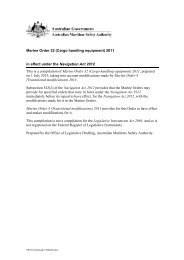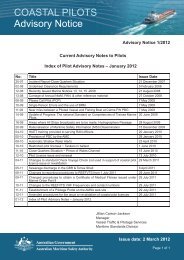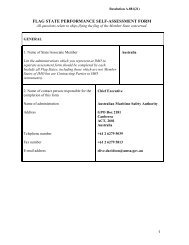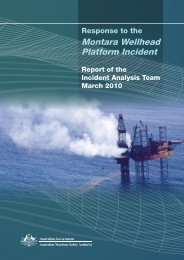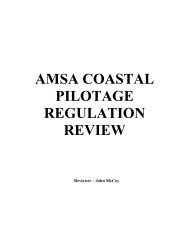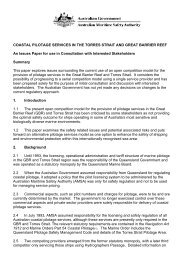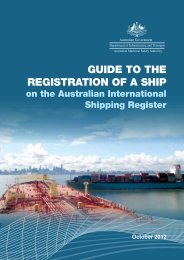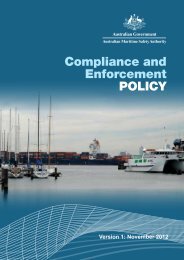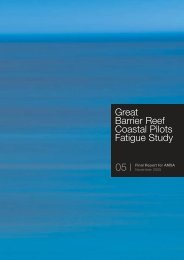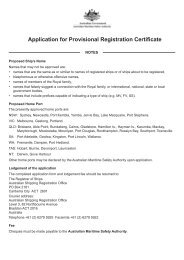Global Peace - Australian Maritime Safety Authority
Global Peace - Australian Maritime Safety Authority
Global Peace - Australian Maritime Safety Authority
Create successful ePaper yourself
Turn your PDF publications into a flip-book with our unique Google optimized e-Paper software.
1INCIDENT DESCRIPTION<strong>Global</strong> <strong>Peace</strong> - Incident Analysis Team ReportOn Tuesday 24 January 2006, at about 2354, thetug Tom Tough experienced engine problemsand landed heavily against the port side of thePanamanian registered bulk carrier <strong>Global</strong> <strong>Peace</strong>(132,049 DWT – built 1982). The incident occurredduring a berthing operation at the Clinton Wharfcoal terminal facility in the port of Gladstone,Queensland.The impact breached the ship’s hull and ruptureda port side fuel tank. Heavy fuel oil flowed intoGladstone harbour from the hole in the ship’s sidefor about 45 minutes. At the time of the incident,the vessel’s port side fuel tank contained about150 tonnes of heavy fuel oil. An amount of heavyfuel oil, later confirmed by an independent bunkersurvey to be 24.53 tonnes was lost into the harbouron the flood tide. No injuries to personnel oneither the ship or the tug were reported.The Port of Gladstone and surrounding areascontain a number of diverse environments, someof which are highly sensitive to the effects ofmarine pollution. These include large areas ofmangroves, intertidal mudflats and seagrass bedsclose to the shipping channel and port area. Themarine environment around Gladstone is alsodocumented as a habitat for seabirds and wadersas well as for turtles, dolphins and dugong. Thearea is also important for the prawn and fishingindustries.The Gladstone Marina, Auckland Creek andBarney Point beach, as well as the islands withinthe harbour, are important recreational areas forthe local community.At 2357, pollution response personnel in the portwere notified and the Port of Gladstone’s FirstStrike Oil Spill Response Plan was activated.MSQ assumed statutory and combat agencyresponsibility almost immediately. The IncidentControl Centre (ICC) was setup in the MSQoffices in Gladstone during the early morning ofWednesday 25 January.The Incident Controller made an initial fielddecision based on personal observations thatdue to OH&S considerations no equipmentdeployment would be undertaken during thehours of darkness.To augment local resources, a range of spillresponse equipment was prepared through thenight for deployment at first light about 0530 onWednesday 25 January. These resources weredrawn from the major stockpiles in Brisbane andTownsville and included four Marco oil recoveryvessels from Townsville, Mackay, Gladstone andBrisbane. AMSA, as manager of the NationalPlan, assisted with mobilising equipment andpersonnel to support the clean-up effort.An overflight was carried out at 0530 to determinethe extent of the oil impacted area and supportdetailed planning to respond to the incident. Anamount of heavy fuel oil was observed in themain channels and waterways system extendingfrom east of Barney Point to Black Swan Island atthe start of The Narrows. Heavy oiling was alsoobserved along the banks and mangroves in theCalliope River (Map 1, refers).A second overflight was carried out at 0900 andtwice daily thereafter. The information gainedfrom the overflights was critical in planning theresponse to the incident. By the end of Day 1,response equipment both local and intrastatehad arrived and been deployed to facilitatecontainment and recovery. Given the inherentgeographical challenges, this was a good result.Early in the morning of Wednesday 25 Januarya decision was made to boom off the mouth ofAuckland Creek with boom that was stored at,and hence readily available in, Gladstone.Calliope River first FlyoverWednesday 25 January at 05:301



